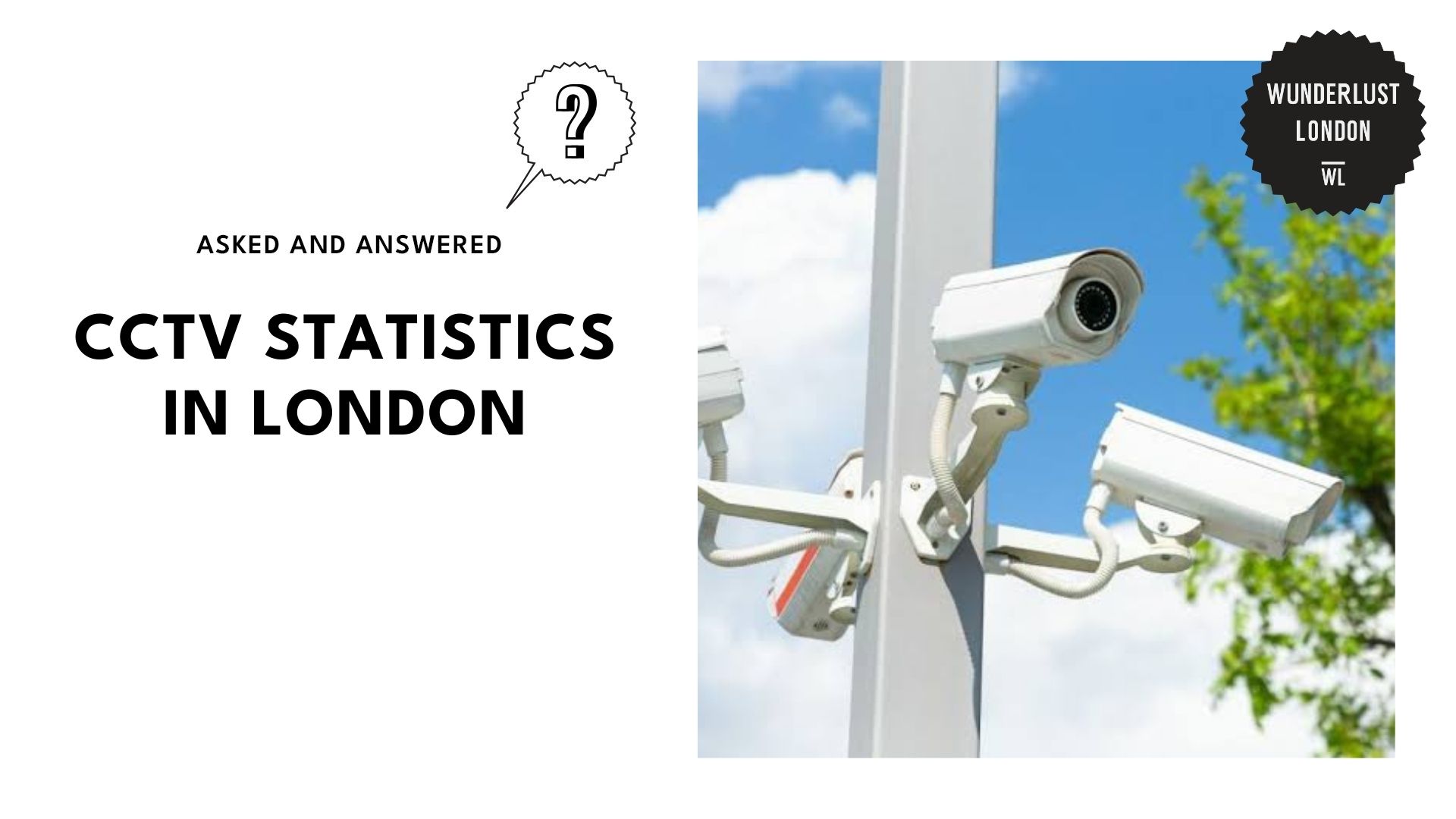Key insights
- In 2022, Clarion Security Systems estimated that London has around 942,000 CCTV cameras.
- Transport for London (Tfl) runs about 15,576 CCTV cameras in the Underground, which is up from 6,500 in 2003, according to Clarion Security Systems.
- Clarion Security Systems reported that Hillingdon had the highest count of CCTV cameras among the London boroughs in 2022.
- According to Ironmongery Direct, the UK local authorities operated 90,597 CCTV cameras in 2024.
- A British Security Industry Association (BSIA) study found that the CCTV cameras in the UK rose from 6 million in 2013 to 21.1 million, mainly due to a 300% increase in private sector use.
- Ironmongery Direct found Haringey had the fastest growth in CCTV installations, while Perth & Kinross saw the largest percentage increase between 2022 and 2024.
- A study found that between 2011 and 2015, CCTV was available in 111,608 crime cases. 72,390 of them aided investigations.
- A 2017 report from the Surveillance Camera Commissioner estimated UK surveillance camera costs at £2.2 billion annually.
- Amid growing privacy concerns with CCTV usage, the London government has implemented measures to protect personal data.
London is often considered one of the most heavily monitored cities in the world. Having 24/7 CCTV surveillance plays a key role in helping to keep the city safe.
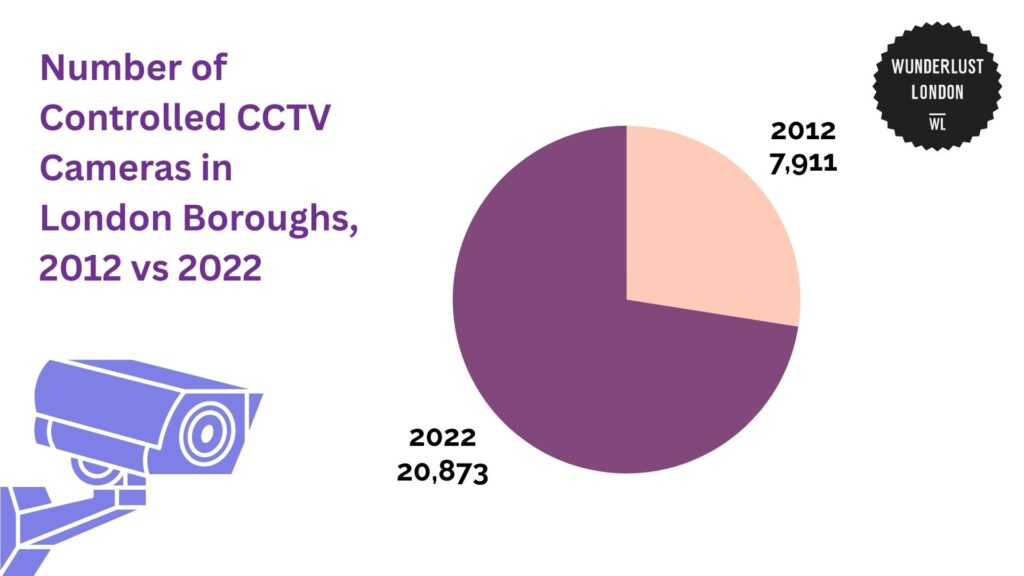
According to research by Clarion Security Systems, the number of government-operated CCTV cameras across the 34 London boroughs rose from 7,911 in 2012 to over 20,873 in 2022.
This marks an increase of approximately 238% over the past decade.
While public CCTV data is readily available, it’s harder to track how many cameras are installed by households and businesses in London.
A 2013 study by the British Security Industry Association (BSIA), as reported by The Standard, estimated there could be up to 6 million CCTV cameras across the UK.
These cameras can be found in trains, shops, and catteries. Even sewage plants and horse farms now have CCTV.
Interestingly, the report suggested that private CCTV cameras outnumber public ones by about 70 to 1.
Although the BSIA report didn’t break down the numbers specifically for London, it showed how much more common private surveillance is compared to government-run systems.
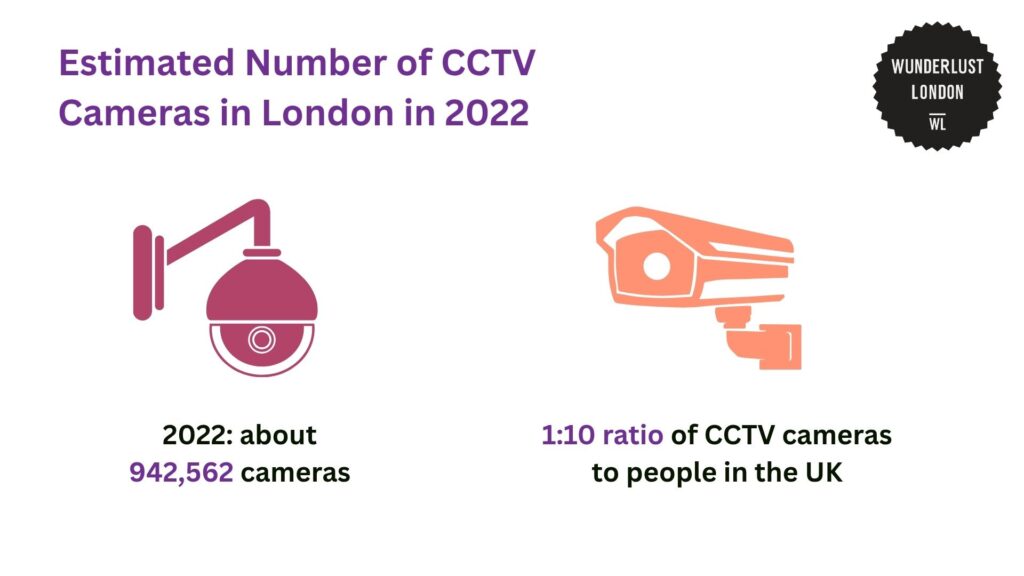
Clarion Security Systems estimates that there were about 942,562 CCTV cameras in London in 2022.
This estimate takes into account the surge in CCTV installations during the COVID pandemic. It’s also based on an earlier BSIA figure that suggested there was roughly one CCTV camera for every 10 people in the UK.
CCTV cameras by Transport for London
CCTV cameras have come a long way over the years. They used to be fixed in places, often attached to walls or poles to watch over a single area. But now, technology has made it possible for people to wear them.
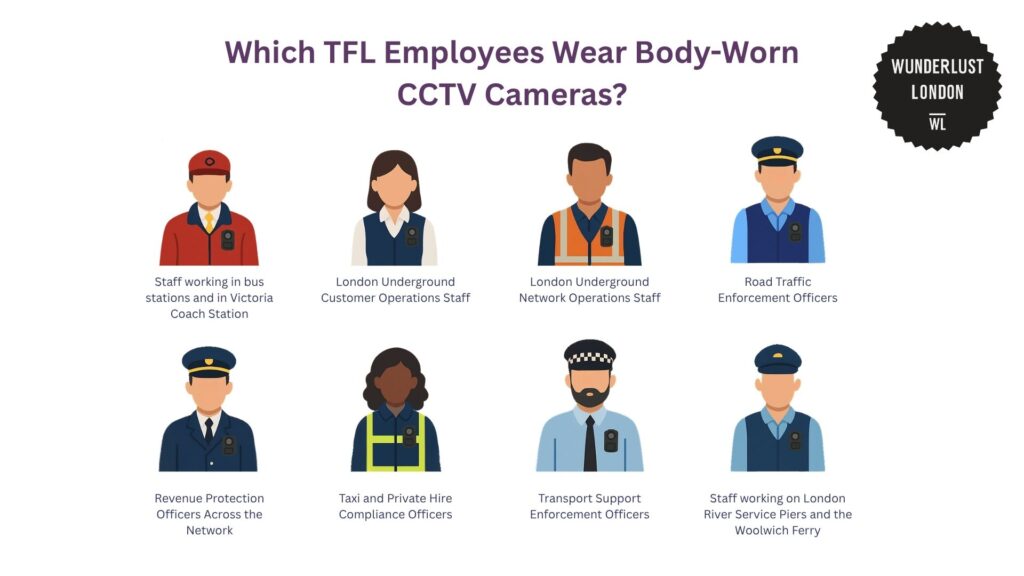
Many Transport for London (TfL) staff who work in high-traffic public areas use body-worn CCTV cameras. This includes employees at bus stations, the Tube, River Service piers, and the Woolwich Ferry.
Enforcement roles like Revenue Protection Officers, Road Traffic Enforcement Officers, and Taxi Compliance Officers also wear cameras to handle confrontational situations and gather evidence.
Transport Support Enforcement Officers, who address rule-breaking and anti-social behaviour, also benefit from this added protection and accountability.
This approach enhances both operational efficiency and safety across various roles within the transport network.
CCTV cameras on the London Underground
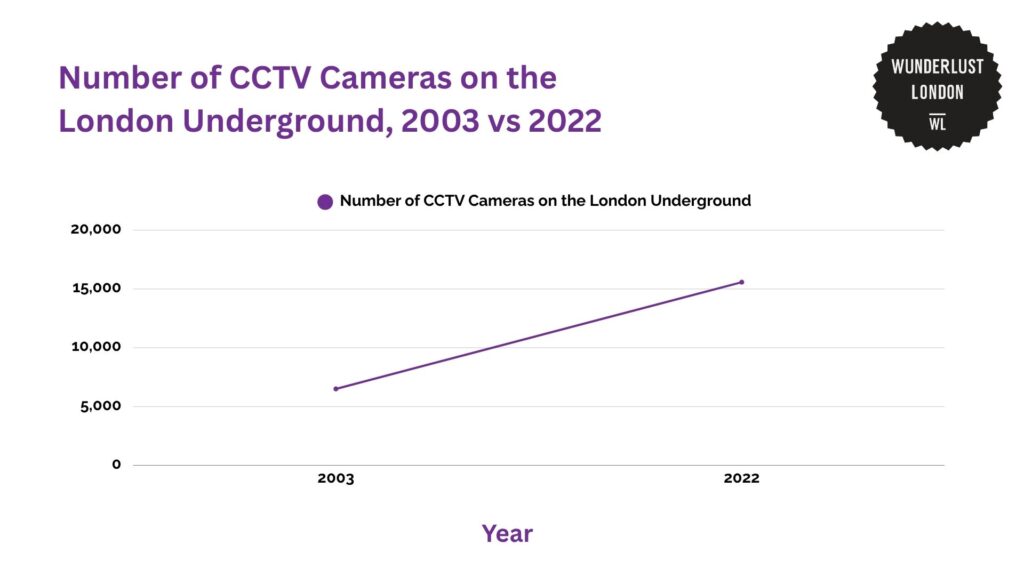
According to Clarion Security Systems, Transport for London (Tfl) operated 15,576 CCTV cameras across the London Underground.
Back in 2003, there were just 6,500 cameras, so that’s a rise of about 139.6%.
These cameras were placed on platforms, inside trains, and in other busy areas to help keep passengers safe.
With millions of people using the Tube every day, the CCTV network plays an important role in reducing crime and managing crowds.
CCTV cameras distribution across London boroughs
Over the past decade, the number of CCTV cameras across London boroughs has grown significantly.
To show you a clear perspective of how it has increased over the years, the following illustration shows the total number of CCTV cameras in London boroughs in 2012 and 2022.
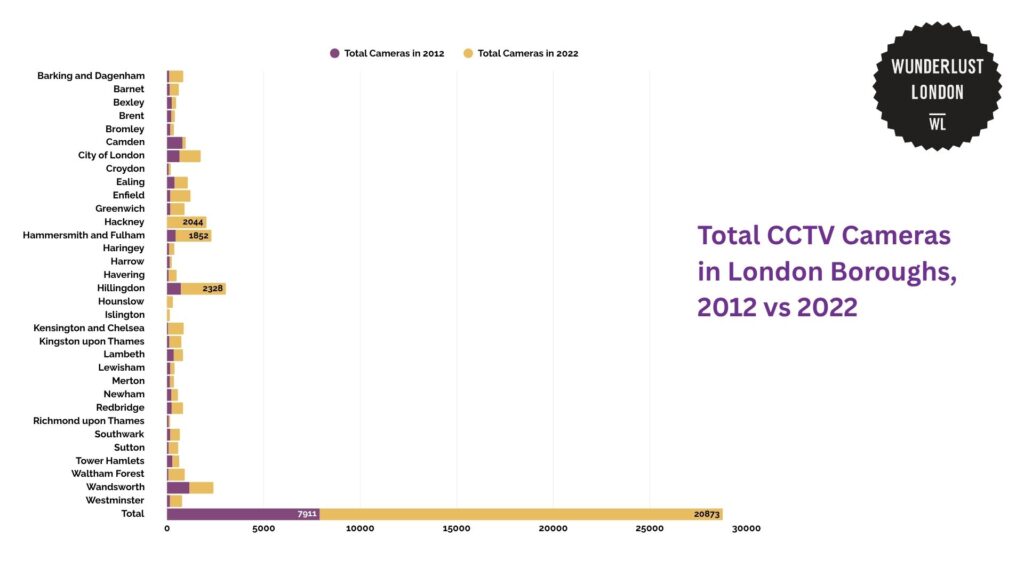
According to Clarion Security Systems, there were just under 8,000 cameras recorded across London in 2012.
By 2022, the number had more than doubled to over 20,000. This sudden increase showed how much more common surveillance has become in everyday life.
Back in 2012, some London boroughs had a lot more CCTV cameras than others. Wandsworth had the most (1,158), followed by Camden (794), and Hillingdon (722).
On the flip side, a few boroughs had very few cameras. Kensington and Chelsea had just 58, and Waltham Forest only had 71. This makes both of the boroughs the lowest that year.
By 2022, Hillingdon had the most CCTV cameras, reaching 2,328. Hackney also had a big total with 2,044 cameras, even though its 2012 numbers weren’t recorded. Hammersmith and Fulham had 1,852 cameras.
At the lower end, Richmond upon Thames had just 80 cameras, which was the lowest of all the boroughs. Islington (148) and Harrow (116) also had relatively few cameras.
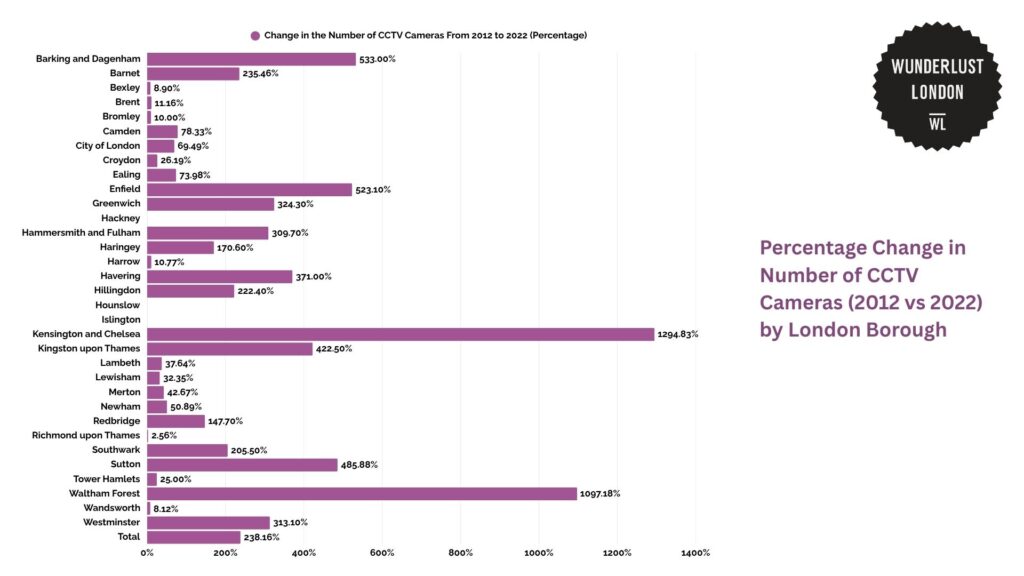
Clarion Security Systems also shared the percentage change in the number of CCTV cameras of the London boroughs from 2012 to 2022.
Some boroughs experienced massive jumps. Kensington and Chelsea had the biggest jump, with 1,294.83% more CCTV cameras than in 2012. Waltham Forest also had a major increase of 1,097.18%.
Other boroughs like Enfield, Sutton, and Greenwich also saw big rises, with each adding hundreds more cameras. Hillingdon, Westminster, and Hammersmith and Fulham more than doubled their totals.
However, not every borough added cameras. A few actually had fewer in 2022 than they did in 2012.
Camden had the biggest drop, losing over three-quarters of its cameras. Bexley, Brent, and Harrow also had small decreases.
A few areas (Hackney, Hounslow, and Islington) didn’t have data available for 2012, so the change over time can’t be determined.
London’s CCTV camera statistics in comparison with the national statistics
In 2022, a study by the British Security Industry Association (BSIA) revealed a big rise in the number of video surveillance cameras in the UK compared to 2013.
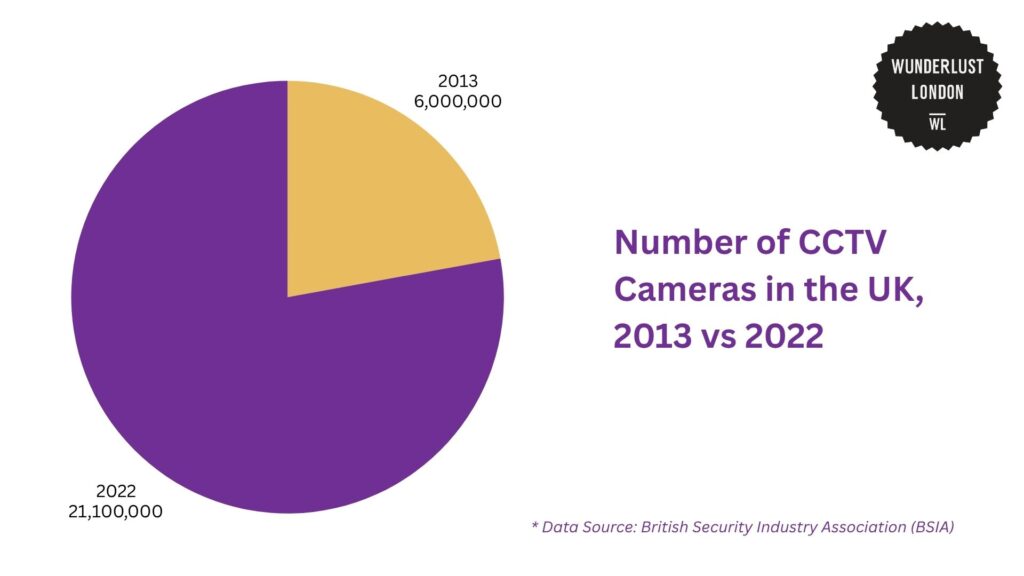
According to the report, there were 21.1 million cameras in 2022, which is up from six million in 2013.
Most of this growth has happened in the private sector, which has seen a 300% increase. Only a small number of the cameras are owned by the public sector.
While 70% of cameras are still used to prevent crime, the study found that 25% are now being used for other business purposes, such as improving operations.
When it comes to the number of CCTV cameras controlled by the local authorities, the numbers were different.
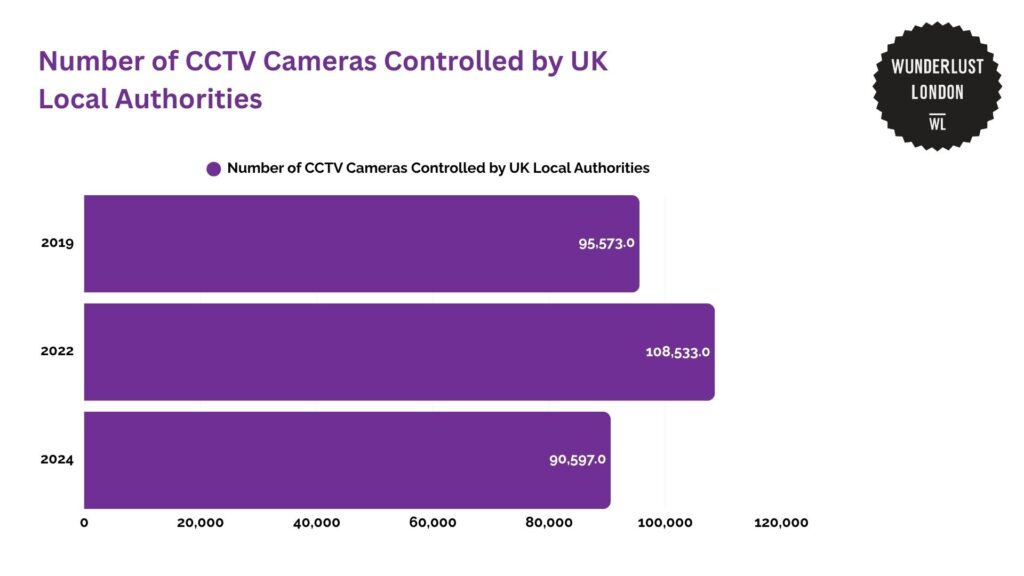
According to Ironmongery Direct, which gathered its data using Freedom of Information requests, the numbers have changed noticeably over the past few years.
In 2019, there were 95,573 cameras in use. That number grew to 108,533 by 2022, showing a clear rise in surveillance efforts during that time.
However, by 2024, the number dropped to 90,597, which might seem surprising at first.
Still, the drop in total numbers doesn’t mean surveillance efforts are slowing down. In fact, almost two-thirds (64%) of local authorities actually increased their CCTV coverage in 2024. Fifty councils more than doubled the number of cameras they operate too.
So while the national total has gone down, many individual councils have ramped up their surveillance.
This could suggest that the overall decrease may be due to a few large councils cutting back or replacing outdated systems, while many others continue to expand their networks.
CCTV hotspots and capitals in the United Kingdom
Most local authorities in the UK have been adding more CCTV cameras, but some are doing it much faster than others.
Ironmongery Direct called these fast-growing areas the UK’s CCTV hotspots. It doesn’t mean they have the most cameras overall, but their numbers are going up the quickest.
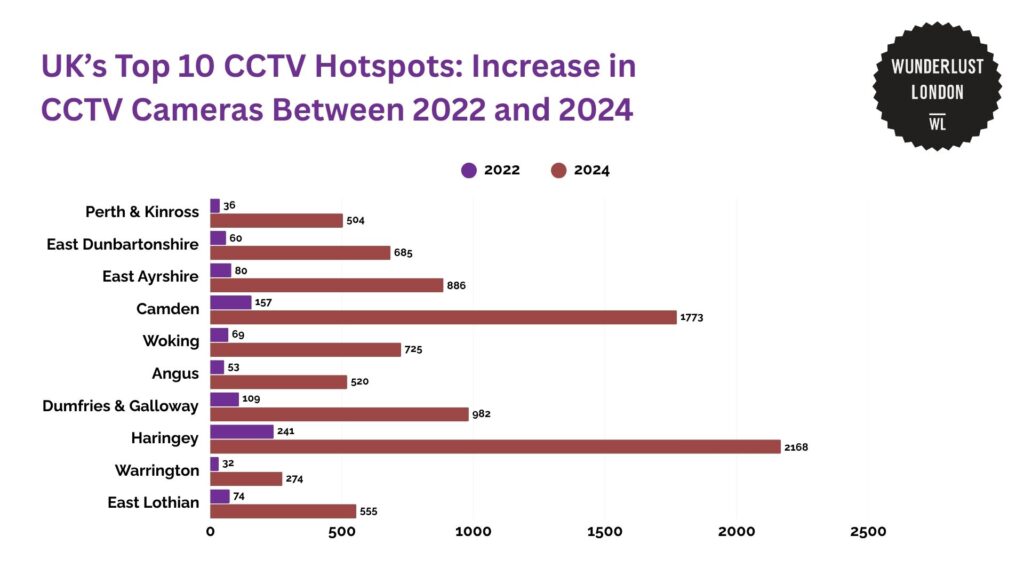
In 2024, Haringey had the highest number of CCTV cameras (2,168). Camden was next with 1,773, followed by Dumfries & Galloway with 982.
On the other hand, Warrington had the fewest cameras with just 32 in 2022 and 274 in 2024. Perth & Kinross (504) and Angus (520) also had lower totals, even though both started with fewer than 60 cameras in 2022.
Back in 2022, the areas with the smallest numbers were Warrington (32), Perth & Kinross (36), and Angus (53).
The ones with the most were Haringey (241), Camden (157), and Dumfries & Galloway (109).
This shows that some places started small but have made big jumps in just two years.
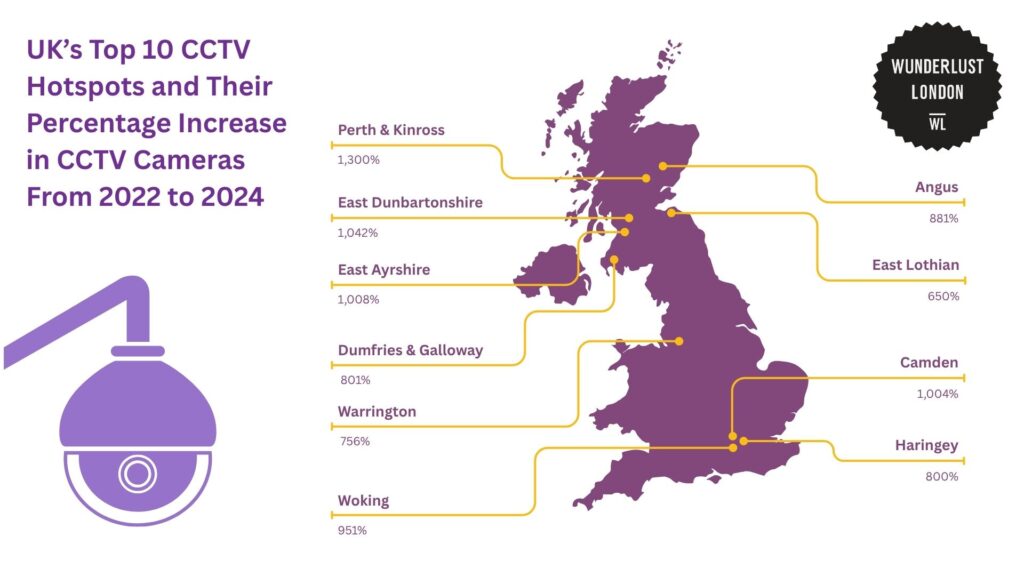
Based on Ironmongery Direct’s data, the percentage increases in CCTV cameras between 2022 and 2024 in the mentioned hotspots were huge.
Perth & Kinross had the biggest change, with a 1,300% increase. It’s a massive leap from just 36 cameras in 2022 to over 500 in 2024.
East Dunbartonshire followed closely with a 1,042% rise, and East Ayrshire wasn’t far behind with a 1,008% increase.
All of this highlights how some councils are expanding their CCTV networks very quickly. This may be to improve public safety, support crime prevention, or monitor local activity more closely.
Some areas in the UK operate a very large number of surveillance cameras. These are known as the UK’s CCTV capitals.
In 2024, 18 councils controlled more than 1,000 cameras each. This showed how widespread surveillance has become in certain parts of the country.
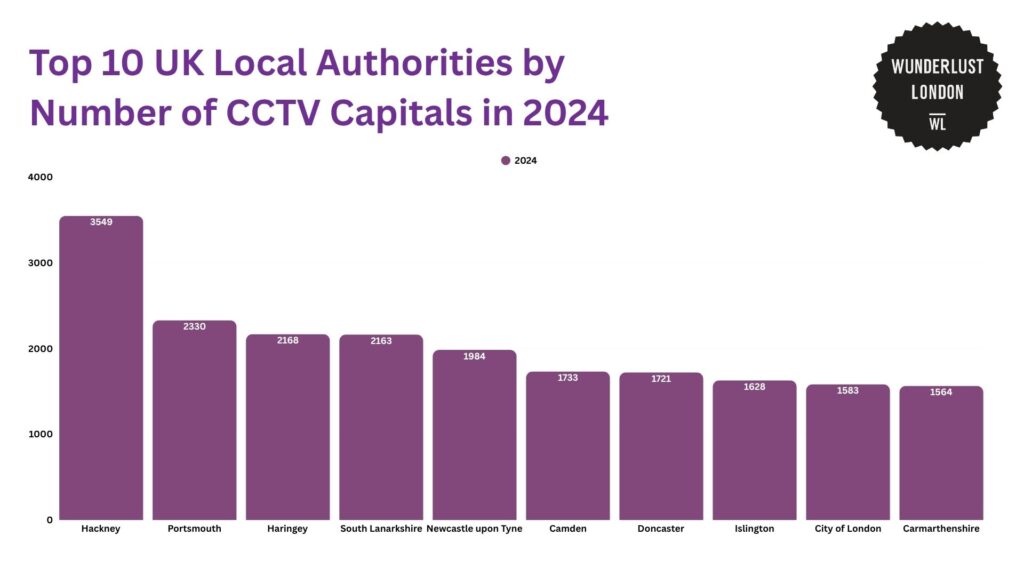
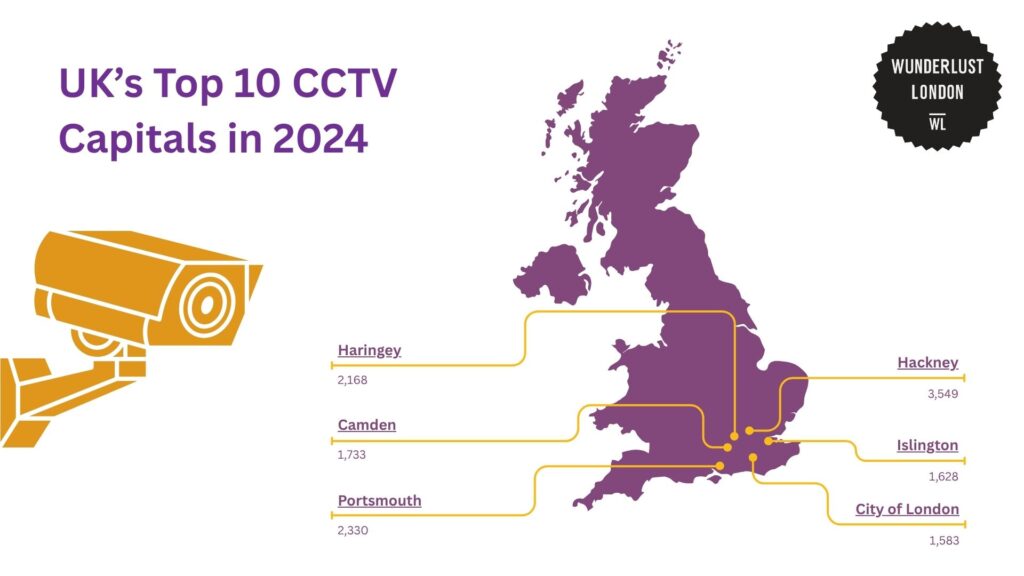
According to Ironmongery Direct, Hackney was the most watched area in the UK. It had 3,549 cameras in 2024, which was 1,219 more than Portsmouth, which came in second with 2,330 cameras.
It’s also interesting to note how half of these CCTV capitals are located in London.
Hackney, Islington, City of London, Camden, and Haringey form a cluster of high-surveillance areas. Together, they create a nearly continuous zone of public monitoring.
This may reflect the city’s focus on urban security, high foot traffic, and densely populated environments.
At the bottom of the top 10 is Carmarthenshire, with 1,564 cameras. While it’s still one of the monitored areas, it has nearly 2,000 fewer cameras than Hackney.
Contributing factors to the rising number of CCTV cameras in London
Crime-solving using CCTVs in London
According to a study, CCTV was available in 111,608 cases between 2011 and 2015. This made up 45.3% of all crimes recorded by the British Transport Police (BTP).
Of those cases, CCTV turned out to be useful in 72,390 investigations. That means CCTV helped in 29.4% of all recorded crimes, and in 64.9% of the cases where footage was actually available.
The footage proved helpful in solving a wide range of crimes.
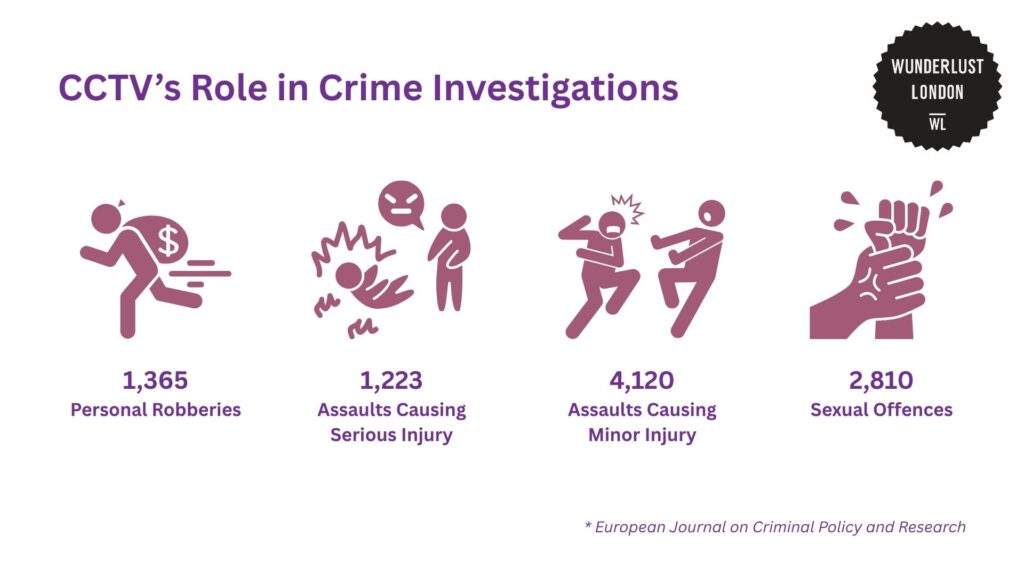
It assisted with 1,223 assaults that caused serious injury, 4,120 assaults that resulted in minor injuries, 1,365 personal robberies, and 2,810 sexual offences.
The effectiveness of CCTV depended on the type of crime.
The study mentioned that CCTV was useful in 62.2% of robbery investigations. However, it was only helpful 10.7% of the time in drug-related cases.
Even though CCTV was often available in vehicle theft cases, it wasn’t always helpful. On the other hand, CCTV was rarely available for drug offences, but when it was, it almost always played a useful role.
Suspect identification using CCTVs in London
The Metropolitan Police Service (Met) had also implemented the Retrospective Facial Recognition (RFR) system.
One of the features of the RFR system is to identify individuals using a photo or short video. This helped in investigations after a crime or incident. These images are usually sourced from CCTV, mobile phone footage, or are shared by the public.
The system compares these images to those in the Met’s custody image database. If it finds a possible match, it’s always reviewed by a human officer to confirm whether the identification is correct.
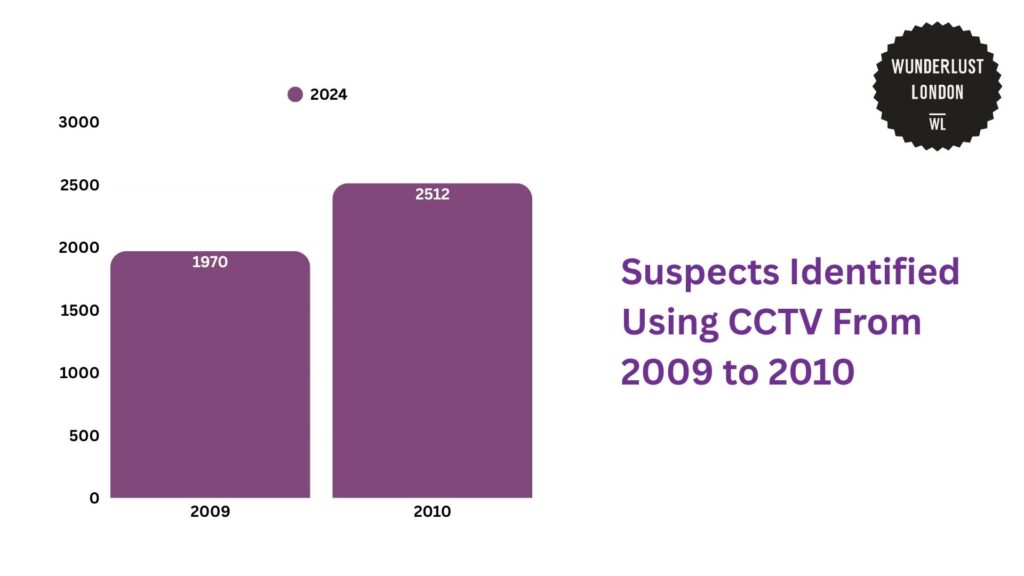
In 2010, BBC News reported that the number of suspects identified using CCTV increased from 1,970 in 2009 to 2,512.
Among those identified were 4 suspected murderers, 23 rapists or sexual offenders, and 5 wanted gunmen.
Crime decrease using CCTVs in London
A study by the College of Policing revealed that CCTV was linked to a clear drop in crime.
On average, crime dropped by 13% in areas with CCTV compared to areas without it.
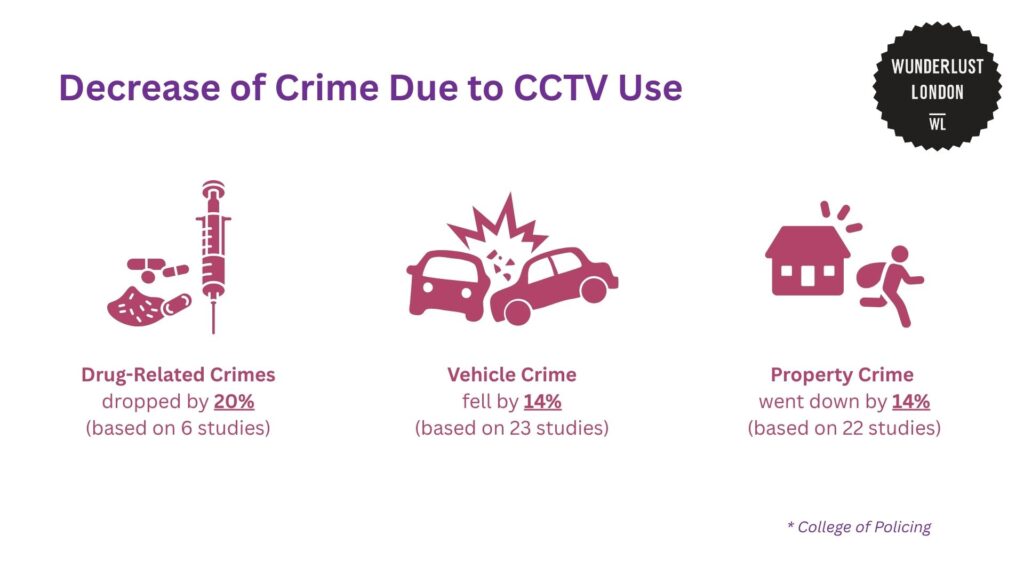
When looking more closely at the types of crime affected, the strongest impact was seen in drug-related offences. It dropped by 20% in locations with CCTV. Vehicle crime and property crime each went down by 14%.
This shows that CCTV works best for crimes that are planned or based on opportunity, like stealing a car or breaking into a shop. People are less likely to commit these crimes if they think they’re being watched.
However, the data from the College of Policing showed no statistically significant change in violent crime or public disorder.
It might suggest that while CCTV may be effective in preventing planned crimes, it may not have the same impact on spontaneous or emotionally driven crimes such as fights or assaults.
These incidents often happen too quickly for surveillance to prevent them, and cameras don’t really stop individuals from acting in the heat of the moment.
Expenditure patterns on CCTV technology in London and the UK
According to a 2017 report of Surveillance Camera Commissioner, the surveillance camera technology in the UK costs approximately £2.2 billion per year.
This figure aligns with findings from a 2012 report by Big Brother Watch, which identified some of the highest-spending areas in the UK on CCTV cameras.
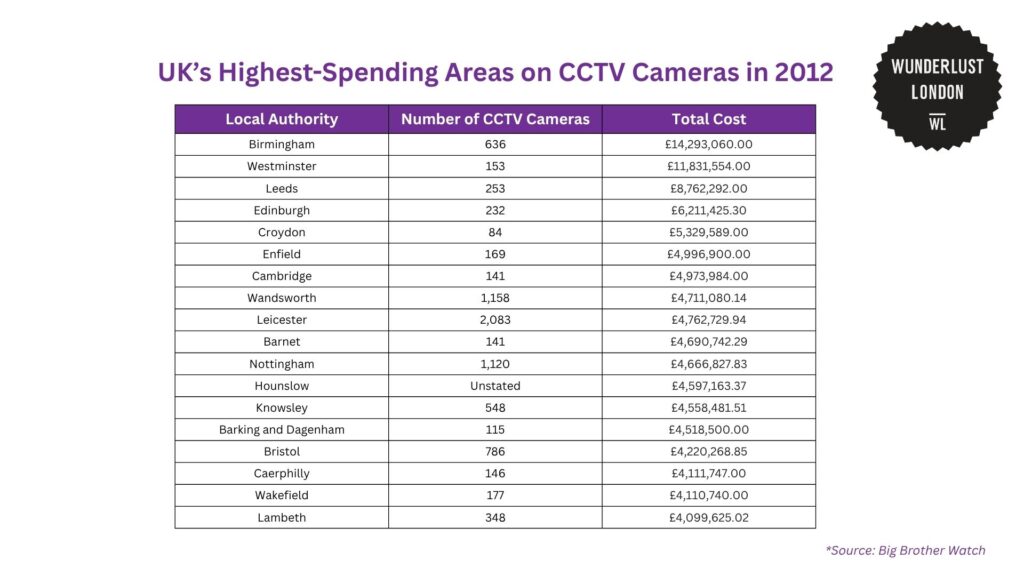
The Big Brother Watch report showed that different local authorities had various approaches in terms of spending and camera installations.
Birmingham, spent the most overall (£14 million), but that covered 636 cameras, which is quite a large number.
In contrast, Westminster spent nearly £12 million but only installed 153 cameras. This suggests that the equipment might have been more advanced or that other costs, like monitoring and maintenance, were higher.
Places like Leicester and Nottingham had a much higher number of cameras while spending less than £5 million. That’s quite a contrast to cities spending more for fewer devices, and it points to a big variation in how money was allocated.
Some councils may have gone for wider coverage using basic systems, while others might have chosen fewer but more high-tech cameras.
There’s also the case of smaller areas like Cambridge and Barnet. Each had under 150 cameras but still spent close to £5 million.
It’s not clear why the cost was so high in these places, but it could be due to installation challenges, extra features, or longer-term contracts.
Privacy concerns in surveillance in London
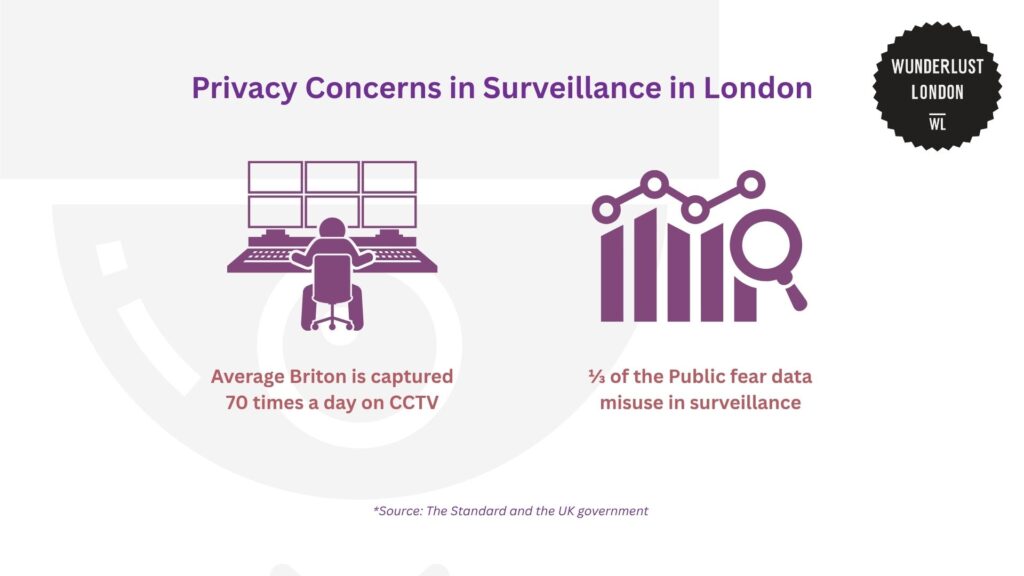
In 2012, The Standard revealed that the average Briton is captured on CCTV around 70 times a day. This figure sparked early concerns about privacy and how surveillance is regulated.
Fast forward to 2024, and the conversation has only become more complex.
According to Wired, AI-powered cameras were recently tested in UK train stations. These advanced systems can detect age, gender, and even emotions. What alarmed many was the lack of public consultation before these trials began.
Critics argued that rolling out such technology without broader input raises questions about transparency, consent, and the potential misuse of personal data.
These concerns are echoed in a recent UK government report. It found that a third of the public are concerned that their personal data could be used for surveillance without their knowledge or control.
How the London government addresses CCTV privacy concerns
With growing privacy concerns around surveillance, the London government has implemented several measures to help protect people’s personal data.
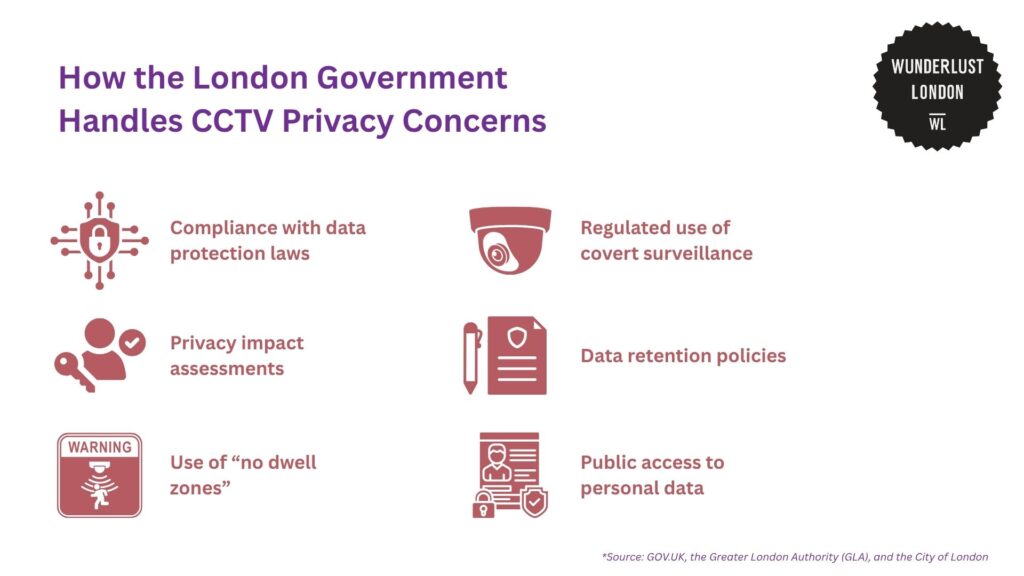
London authorities follow strict rules from the UK General Data Protection Regulation (UK GDPR) and the Data Protection Act 2018 to protect people’s personal data. These rules set clear guidelines for how CCTV footage is collected, stored and used.
To make sure these rules are followed, the Greater London Authority (GLA) has its own Data Protection Policy.
Before starting any new surveillance projects, the GLA carries out Data Protection Assessments (DPIAs) to check for privacy risks and fix any issues early on.
These assessments are shared in the London Privacy Register so the public can see what steps are being taken.
To protect people’s privacy, especially around homes, some CCTV systems have “no dwell zones.” These zones automatically block the camera’s view when it moves over private properties, so it doesn’t record anything there.
Covert surveillance is only used in serious cases, like criminal investigations. Before it’s approved, law enforcements and other officials carefully review how it might affect people’s privacy.
CCTV footage is also usually kept for only about 10 days unless it’s needed for ongoing investigations. This helps avoid storing people’s personal data longer than necessary.
People also have the right to see any CCTV footage that includes them by sending a Subject Assess Request (SAR). The government has made this process simple so everything stays transparent and fair.
These measures collectively aim to balance the benefits of CCTV surveillance to help keep people safe while also protecting people’s privacy.
References
- Ashby, M. P. J. (2017). The value of CCTV surveillance cameras as an investigative tool: An empirical analysis – european journal on criminal policy and research. SpringerLink. https://link.springer.com/article/10.1007/s10610-017-9341-6
- BBC. (2010). “Six crimes a day” solved by CCTV, met says. BBC News. https://www.bbc.com/news/uk-england-london-12080487
- Big Brother Watch. (2012). The price of privacy: the £515m cost of CCTV. https://bigbrotherwatch.org.uk/wp-content/uploads/2012/02/The-Price-of-Privacy.pdf
- Billinge, S. (2022). How many CCTV cameras in London? UK CCTV numbers (updated 2022). Clarion UK. https://clarionuk.com/resources/how-many-cctv-cameras-are-in-london/
- Burgess, M. (2024). Amazon-powered AI cameras used to detect emotions of unwitting UK train passengers. Wired. https://www.wired.com/story/amazon-ai-cameras-emotions-uk-train-passengers
- Bus CCTV retention policy and GDPR. London City Hall. (2018). https://www.london.gov.uk/who-we-are/what-london-assembly-does/questions-mayor/find-an-answer/bus-cctv-retention-policy-and-gdpr
- CCTV & Surveillance Cameras. Transport for London. (n.d.). https://tfl.gov.uk/corporate/privacy-and-cookies/cctv#on-this-page-2
- CCTV capitals of the UK: 2024 report. IronmongeryDirect. (2024). https://www.ironmongerydirect.co.uk/blog/cctv-capitals-of-the-uk-2024-report
- Closed-Circuit Television (CCTV) . College of Policing. (n.d.). https://www.college.police.uk/research/crime-reduction-toolkit/cctv
- Closed-Circuit Television (CCTV) Policy. City of London. (2022). https://www.cityoflondon.gov.uk/assets/Services-DCCS/cctv-policy-2022.pdf
- Evening Standard. (2012). We’re watching you: “britons caught on CCTV 70 times a day.” The Standard. https://www.standard.co.uk/hp/front/we-re-watching-you-britons-caught-on-cctv-70-times-a-day-6573202.html
- Evening Standard. (2013). Spy Britain: Six Million CCTV cameras – and most are in private hands. The Standard. https://www.standard.co.uk/news/uk/spy-britain-six-million-cctv-cameras-and-most-are-in-private-hands-8699934.html
- GDPR and public access requests for bus CCTV evidence. London City Hall. (2018). https://www.london.gov.uk/who-we-are/what-london-assembly-does/questions-mayor/find-an-answer/gdpr-and-public-access-requests-bus-cctv-evidence
- GLA Data Protection Policy. Greater London Authority. (2020). https://www.london.gov.uk/sites/default/files/2023-05/GLA Data Protection Policy v3.pdf
- GOV.UK. (2025). Data protection. GOV.UK. https://www.gov.uk/data-protection
- Live facial recognition. Metropolitan Police. (n.d.). https://www.met.police.uk/advice/advice-and-information/facial-recognition/live-facial-recognition/
- London Privacy Register. London Data Store. (2024). https://data.london.gov.uk/dataset/london-privacy-register
- Moore, J. (2022). BSIA’s bigger picture report underlines growing use of video surveillance for business operational purposes – IFSEC global | security and fire news and resources. IFSEC Insider. https://www.ifsecglobal.com/video-surveillance/bsias-bigger-picture-report-underlines-growing-use-of-video-surveillance-for-business-operational-purposes/
- Public attitudes to data and AI: Tracker Survey (wave 4) report. GOV.UK. (2024). https://www.gov.uk/government/publications/public-attitudes-to-data-and-ai-tracker-survey-wave-4/public-attitudes-to-data-and-ai-tracker-survey-wave-4-report
- Surveillance Camera Commissioner. (2018). Surveillance Camera Commissioner Annual Report 2016/17 . https://assets.publishing.service.gov.uk/media/5a74e95940f0b65f613233db/CCS207_CCS0118716124-1_Annex_A_-_AR_2017-_web.pdf
- TFL CCTV and Privacy. Greater London Authority. (2014). https://www.london.gov.uk/who-we-are/what-london-assembly-does/questions-mayor/find-an-answer/tfl-cctv-and-privacy


